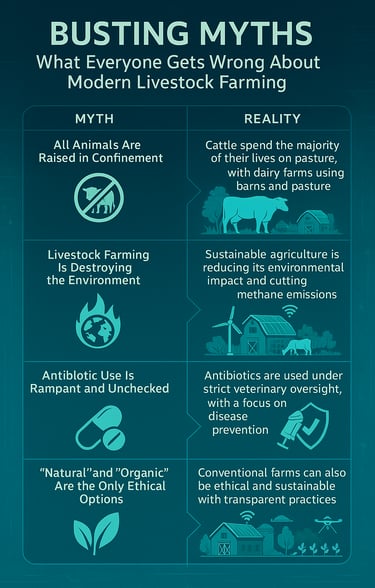Busting Myths: What Everyone Gets Wrong About Modern Livestock Farming
Mr. Diyan Ahmed
10/1/20253 min read


In today's digital age, information—and misinformation—travels at the speed of a click. For the modern livestock farming industry, this has led to a proliferation of myths and misconceptions that can cloud the public's understanding of where their food comes from. The gap between farm and fork has widened, creating a breeding ground for inaccurate perceptions about animal welfare, environmental impact, and farming practices.
It's time to set the record straight and provide some factual information to help debunk farm myths and highlight the truth behind modern farming practices.
Myth #1: All Animals Are Raised in Confinement
The image of overcrowded, unsanitary factory farms is a powerful one, but it doesn't represent the full picture of modern livestock farming.
The Reality: While some animals are raised in barns or controlled environments for safety and efficiency, a significant portion of the world's beef, lamb, and goat production is based on grazing. Cattle spend the majority of their lives on pasture, and many dairy farms use a combination of barn housing (for protection from weather and heat stress) and pasture access.
The Why: Farmers prioritize animal welfare not just for ethical reasons, but because it's good for business. Stressed or unhealthy animals are less productive and more susceptible to disease, which directly impacts a farmer's bottom line. Modern barns are designed with advanced ventilation, cooling systems, and space requirements to ensure animal comfort and health.
Myth #2: Modern Agriculture is Inherently Bad for the Environment
Many believe that large-scale farming is a primary driver of environmental degradation.
The Reality: The environmental impact of farming is a complex issue, but modern sustainable agriculture is actively working to reduce its footprint. Innovations in feed science have improved feed efficiency, meaning animals produce more with less, which reduces the need for land and resources. Additionally, practices like regenerative grazing (which we discussed in a previous post) actively improve soil health and sequester carbon.
The Truth about Methane: While livestock, particularly cattle, produce methane, it's crucial to understand the context. Biogenic methane from cattle is part of a natural cycle, and a new generation of feed additives is significantly reducing methane emissions from the animals.
Food Waste: A major part of the environmental puzzle is often overlooked: food waste. Livestock play a crucial role in converting food byproducts and plant matter that humans can't eat into high-quality protein, which reduces overall food waste.
Myth #3: The Use of Antibiotics in Livestock is Widespread and Uncontrolled
The use of antibiotics in animals is a significant concern for consumers, but the practices are far more regulated than many people realize.
The Reality: Antibiotics are used in livestock production to treat, control, and prevent disease, but under strict veterinary guidance. The vast majority of meat sold today is free of antibiotic residues. In many countries, there are mandatory withdrawal periods, which means an animal cannot be sent to processing until the antibiotics have cleared its system.
A Focus on Prevention: The ultimate goal of any good farmer is to minimize the need for antibiotics in the first place. Through excellent livestock health management, including good nutrition, sanitation, and vaccination programs, farmers are proactively preventing disease, leading to a healthier herd and less reliance on medication.
Myth #4: "Natural" and "Organic" are the Only Ways to Farm Ethically
Consumers often rely on labels to guide their purchasing decisions, but the terms can be confusing and don't always tell the whole story.
The Reality: While organic farming adheres to a specific set of standards, it doesn't always guarantee superior animal welfare or environmental outcomes. Many conventional farms, without an organic label, adopt practices that are just as, if not more, humane and sustainable.
The Key is Transparency: A better indicator than a single label is food industry transparency. Look for farms that are willing to share their story, invite you to their property (either in person or through social media), and answer your questions directly. These producers, whether they are organic or conventional, are often the most committed to ethical and sustainable practices.
Conclusion
Understanding livestock farming facts is about moving past simplified narratives and embracing the complexity of a modern food system. The industry is constantly evolving, driven by research, consumer demand, and a new generation of farmers committed to innovation and sustainability. By seeking out the truth and supporting producers who are transparent about their practices, we can build a food system based on trust, not misinformation.
Connect
Partnering for innovation across industries.
Explore
Discover
+923001534092
© 2025. All rights reserved.
